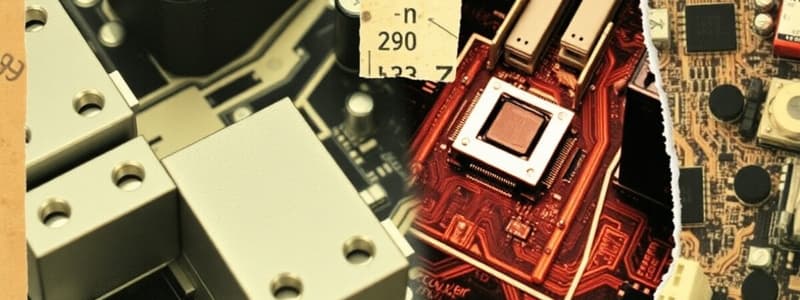Podcast
Questions and Answers
What is the standard size for the motherboard power connector used today?
What is the standard size for the motherboard power connector used today?
- 24-pin (correct)
- 18-pin
- 22-pin
- 20-pin
What voltage does the main motherboard power connector provide?
What voltage does the main motherboard power connector provide?
- 5.5 volts
- 12 volts
- 5 volts
- 3.3 volts plus or minus 5 volts and plus or minus 12 volts (correct)
What feature ensures the connector can only be inserted one way into the motherboard?
What feature ensures the connector can only be inserted one way into the motherboard?
- Magnetic attachment
- Keyed pins (correct)
- Color coding
- Locking mechanism
Which connector typically provides 12 volts power specifically for the CPU?
Which connector typically provides 12 volts power specifically for the CPU?
What designation does 'ATX' refer to in the context of motherboards?
What designation does 'ATX' refer to in the context of motherboards?
What should be done before connecting the power supply to the motherboard?
What should be done before connecting the power supply to the motherboard?
What helps secure the connection between the power supply and the motherboard?
What helps secure the connection between the power supply and the motherboard?
How can a 24-pin connector be used with a motherboard that has a 20-pin connector?
How can a 24-pin connector be used with a motherboard that has a 20-pin connector?
What is the main purpose of SATA connectors on a motherboard?
What is the main purpose of SATA connectors on a motherboard?
What does the eSATA connection provide?
What does the eSATA connection provide?
What are pin headers on a motherboard primarily used for?
What are pin headers on a motherboard primarily used for?
Which component might you connect to an M.2 connector on a motherboard?
Which component might you connect to an M.2 connector on a motherboard?
How are the labels on the pin headers of a motherboard helpful?
How are the labels on the pin headers of a motherboard helpful?
What is typically required to install an SSD into an M.2 connector?
What is typically required to install an SSD into an M.2 connector?
Which of the following describes a common feature of pin headers related to fan controls?
Which of the following describes a common feature of pin headers related to fan controls?
In addition to SATA connections, what is another feature often present on motherboards for connecting storage devices?
In addition to SATA connections, what is another feature often present on motherboards for connecting storage devices?
What is an advantage of using an SSD with an M.2 connector?
What is an advantage of using an SSD with an M.2 connector?
What can be inferred about the labeling of connectors on computer cases?
What can be inferred about the labeling of connectors on computer cases?
Flashcards
Motherboard Power Connector
Motherboard Power Connector
A connector on the motherboard that receives power directly from the power supply, supplying 3.3V, 5V, and 12V to the motherboard. It was originally 20-pin but now is typically 24-pin.
Keyed Connector
Keyed Connector
A type of connector that ensures a secure connection by using keys to prevent incorrect insertion. These keys are present on both the connector and the motherboard, matching in shape.
24-pin Connector
24-pin Connector
A 24-pin connector on the motherboard, typically found at the bottom, that receives power from the power supply.
ATX 12 Volt CPU Connector
ATX 12 Volt CPU Connector
Signup and view all the flashcards
ATX
ATX
Signup and view all the flashcards
Connector Lock
Connector Lock
Signup and view all the flashcards
Pins
Pins
Signup and view all the flashcards
CPU Socket
CPU Socket
Signup and view all the flashcards
eSATA
eSATA
Signup and view all the flashcards
Pin Headers
Pin Headers
Signup and view all the flashcards
Trusted Platform Module (TPM)
Trusted Platform Module (TPM)
Signup and view all the flashcards
M.2 Connector
M.2 Connector
Signup and view all the flashcards
Case Connectors
Case Connectors
Signup and view all the flashcards
Reset Switch Connector
Reset Switch Connector
Signup and view all the flashcards
Fan Header
Fan Header
Signup and view all the flashcards
Legacy USB Connector
Legacy USB Connector
Signup and view all the flashcards
USB 3.0 Connector
USB 3.0 Connector
Signup and view all the flashcards
Study Notes
Motherboard Connectors
-
24-pin ATX Power Connector: Provides main motherboard power (3.3V ±5V and ±12V). Replaced the older 20-pin connector. Some power supplies are modular, allowing for 20-pin and 24-pin options. Pins have keys for correct orientation.
-
4-pin ATX 12V CPU Power Connector: Provides 12V power for the CPU. Located near the CPU socket. Identified by "CPU," "P4," or "ATX 12V" markings. Also uses keyed pins for correct insertion.
-
SATA Connectors: Connect hard drives and SSDs. Colored connectors indicate SATA (Serial ATA) type. Used for internal storage. External drives can also be connected.
-
eSATA Connectors: External Serial ATA connectors. Allows for external storage devices. May require an expansion card, depending on the motherboard design.
-
Pin Headers: Groups of pins on the motherboard edge. Often used for power, USB connectivity, or case button connections. May have labels ("AAFP" for audio, various USB types).
-
TPM Connector: Trusted Platform Module connection. Often a header providing for security connection.
-
USB Connectors (Various Types): Includes legacy USB, USB 3.0, and newer types.
-
Cooling Fan Connectors: Provide power and control for cooling fans.
-
Case Connectors: Connect on/off, reset, and status light buttons. Have labeled connectors.
-
M.2 Connectors: Newer, smaller connectors for high-speed SSDs. SSD is directly inserted and secured.
Studying That Suits You
Use AI to generate personalized quizzes and flashcards to suit your learning preferences.


